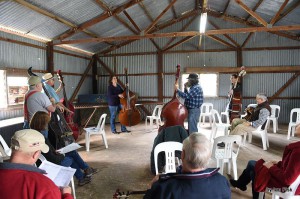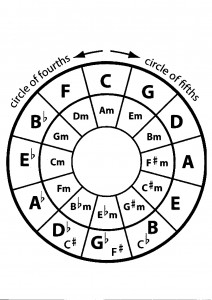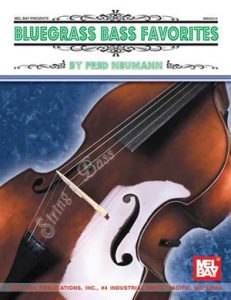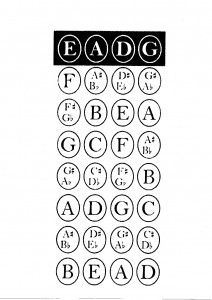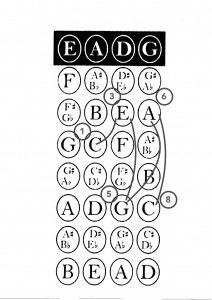Jenine’s Guide to being a passable bluegrass bass player
When I started playing the bass I invented my own shorthand to quickly sketch out songs I was learning so I could print out a whole lot of them on a single piece of paper and blue tack them to the bass. The notation is based on playing “bass chords.” A bass chord consists of two notes, two beats. The first note you play is the root of the chord on the first beat of the bar, and the second note is the fifth of the chord on the third beat. So if you are playing a G chord, you play the G note and then a D.
Ex:
Jenine’s notation: G3 C1 D1 G1
This reads “Play three G chords, then one C chord, one D chord, and one G chord.” 12 beats total: G, D, G, D, G, D, C, G, D, A, G, D.
Might be written for guitar as: / G G / G C / D G /
What my notation doesn’t take into account very well is transcribing to other keys. For this you need to know your circle of fifths:
My bass cheat sheet has over 100 songs on it right now. You can find it here:
JENINE’S BLUEGRASS BASS PLAYER CHEAT SHEET. This is not a complete list of the songs that the Pipis play, just the ones that I have charted and that you are most likely to encounter in a jam session. If there are any specific Pipi songs you’d like my cheats for, just ask.
I’m not 100% sure on all my counts there. If you find a mistake you can e-mail it to me, or you can request access to edit the sheet. If you chart up any songs that aren’t there using the same notation, please request access so you can add them to the sheet for others to enjoy! I’m going to continue adding songs as well, and hopefully eventually they’ll ALL be there.
Fred Neumann has put a book together that uses a very similar notation to mine. It’s called the Bluegrass Bass Favourites and it’s available for immediate download as an ebook from Mel Bay. Only US$10, it’s a great resource. (I have found the odd error in there, too, so just keep an eye out.)
Here’s a nice chart of what the notes on the bass strings are at each “fret.” Jenine’s first rule of playing the upright bass: put cheat marks on the fret board. Ain’t nobody got time to guess where their fingers oughtta be, and if you’re standing next to a frikkin’ banjo player you probably can’t reliably hear if you’re hitting the right note. So get out your pencil and your tuner and mark that thing. I used a bit of white-out (or twink) and some glow in the dark nail polish. Non-destructive methods you could use: slices of masking tape or blue tack.
These are two possible fingering patterns for a boogie-woogie walking bass line. Once you know them, you can move the (1) note anywhere else to start and play in that key. The first chart shows the pattern playing a G arpeggio. The second is in the key of C. To play the first pattern in the key of B, for example, you move your starting point, the (1), up one string and up one fret. Voila. You can now boogie-woogie in any key!
Jenine’s Bass Workshop
- Standing with your bass.
- How to hold your arms.
- Paying attention to your hands.
- Hand exercises
- Vulcan hands
- Tapping one finger at a time
- Testing your technique
- Intonation using double stops and a bow.
- Left hand pressure
- The basics: 1 and 5. Up and down.
- Play open strings whenever possible
- Common keys: 1, 4, and 5
- Transposing keys
- Circle of fifths (fourths)
- Knowing your fingerboard
- Paul Kowert (Punch Brothers) on “Bottom of A Glass”
- 2nd position, frets 2, 3, and 4.
- Make sure your hand goes straight across, not up or down.
- Elbow up and moving around to front of bass
- Now you’re a passable bluegrass bass player.
- Nine Pound Hammer in multiple keys
- Playing more than just 1 and 5 on beats 1 and 3
- Transitions between chords (fills)
- Mark Fain of Kentucky Thunder on Ricky Skaggs “The Old Home”. Master class in bluegrass bass.
- Double on the 1 before changing chords
- From the 1 to the 5, hit the 6 on the way down. Add a note to fill.
- From the 1 to the 4, drop to the lower 1 and hit the 3 coming up.
- Overshoot by two steps and come back down.
- Working with the metronome
- Start with quavers, crutches, semiquavers, and then remove signal notes
- Arpeggio patterns
- Exploring different rhythms
- Don’t let your time suffer for the sake of fancy
- Ghost notes
- “Two feel”
- Singing and playing
- Your alliance with Dolly and Missy
- Not Parton and Raines, unfortunately.
- Dolly = left hand, Missy = right hand.
- Your alliance with Dolly and Missy
- Walking and playing

